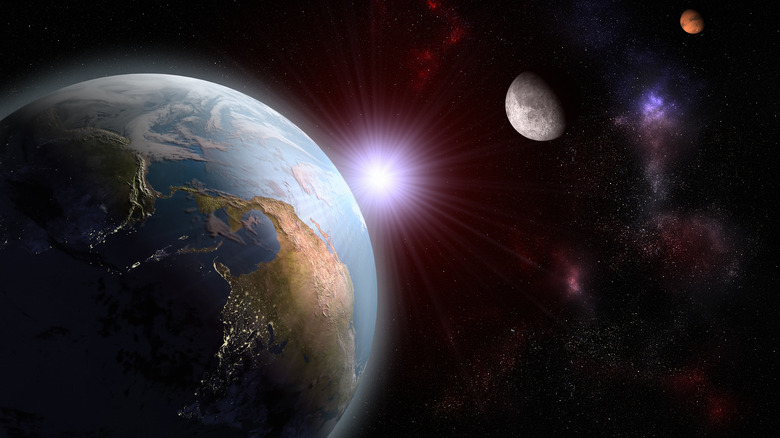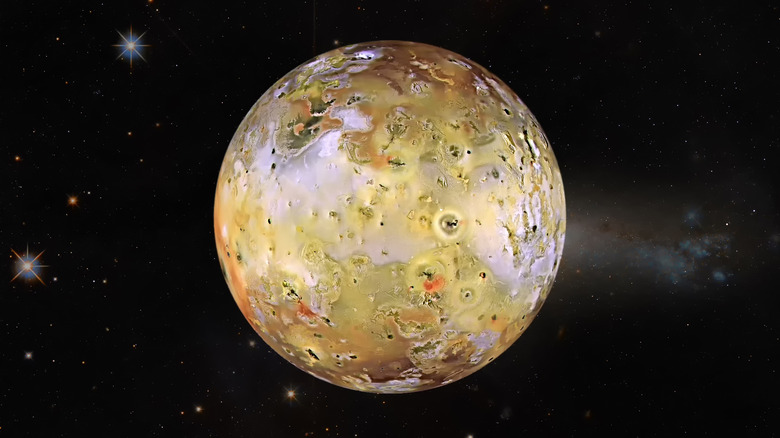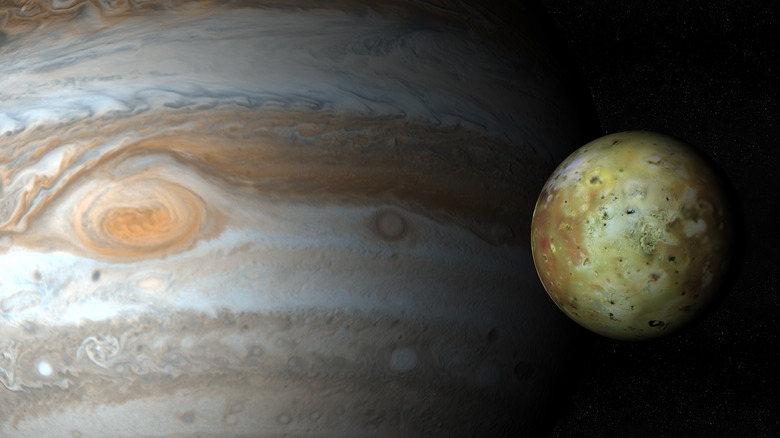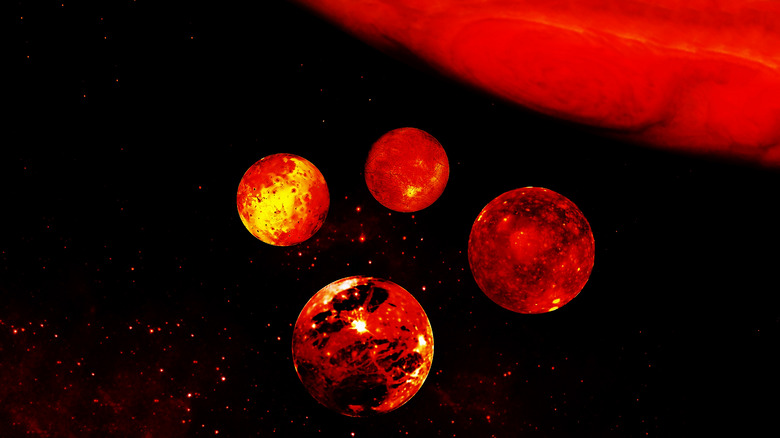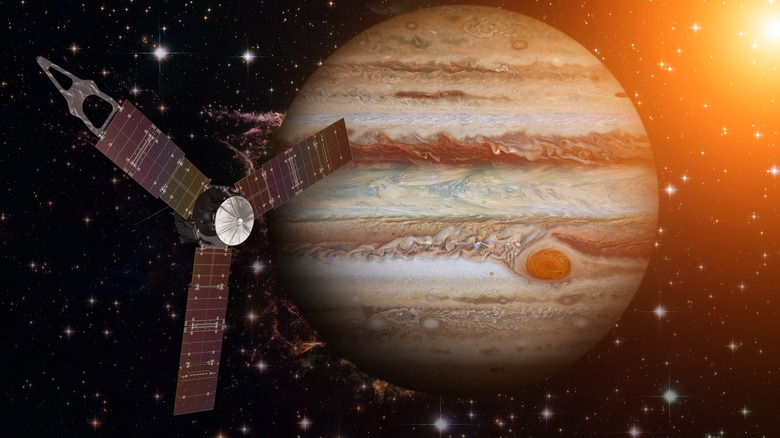The Most Volcanically Active Place In The Solar System
More than 80% of Earth is volcanic, a potential landmine just waiting to erupt (via USGS). According to science, Earth's volcanic origins played a massive part in shaping the ever-shifting landscape of this planet we call home, which explains why Earth's surface is so, shall we say, explosive. To this very day, eruptions of molten volcanic ash affect several aspects of the weather. The drifting clouds, the sparkling sunsets, and even the overall temperature are heavily impacted by volcanic ash and gas to the point where our entire planet can become encompassed by a massive volcanic cloud (per USGS).
While we tend to associate volcanic activity with catastrophic events that were disastrous to humanity, such as Pompeii, for example, it is more accurate to view it as an impactful force that shapes our world. According to National Geographic, tectonic plates and volcanic rocks are known to create mountains, sculpt islands, and more. And that's just what we see on the surface. A scrupulous view through a telescope reveals that volcanic activity is in no way limited to Earth. If you look at the world through an even broader lens, you will find the solar system is virtually bursting with active volcanoes. One unexpected place, in particular, is shooting lava miles into the sky (per NASA).
The solar system's most volcanic area
According to CNN, NASA scientists who have been observing Jupiter just deemed Io, one of Jupiter's moons, the most volcanic area in the solar system. This is really saying something, when you consider the heavily volcanic origins of Earth (via USGS) and even other places within the solar system like Triton, one of Neptune's moons, which spews out ice volcanoes measuring minus 300 degrees (per the Chicago Tribune).
According to NASA, Io, which is Jupiter's third-largest known moon, is "a true volcanic wonderland with hundreds of erupting volcanoes" spewing lava toward the sky. This area is a hotbed covered in molten ash, a place where volcanic lava shoots out dozens of miles in the air. According to Space, Io's volcanoes can burn at a rate of about 3,000 degrees Fahrenheit while the surface temperature is minus 202 degrees Fahrenheit. This unique situation lends Io the nickname "celestial body of fire and ice."
The high level of volcanism combined with unfathomable radioactivity has made Io a seemingly uninhabitable planet, at least for the sort of life humanity understands. However, there is still room for the possibility of alien life outside of human expectations, the kind of beings that might withstand radioactive blasts and mile-high lava cascades (per NASA).
Io's volcanic activity is the result of gravitational pull
Oftentimes, when we think about space, we picture a complete lack of gravity, envisioning foreign objects aimlessly drifting through a sky of swirling stars and orbiting planets. However, according to NASA, gravity likely exists in virtually every corner of the solar system, just in smaller doses than we find on Earth. This kind of gravity, known as microgravity, is what holds the moons and planets in their places.
Likewise, gravity is also believed to be the driving force behind Io's extreme volcanic activity. NASA reports that Io's position between Jupiter and the two moons known as Europa and Ganymede is largely to blame for the gushing magma and oozing lava in outer space. According to Universe Today, Jupiter's gravitational pull is 2.5 times stronger than Earth's. Io is wedged between this massive force of gravity and the two moons mentioned above. As these celestial bodies orbit and rotate through space, they kind of squeeze Io, distorting its shape and causing its surface to bulge both vertically and horizontally.
This process results in massive amounts of tidal heating which is defined by University of California, Berkeley as "the repeated deformation of a body (for example, a moon) due to tides from another body (for example, a planet), which leads to heating of the former's interior."
Io's interior is 20 times hotter than Earth's
Tidal heating is a hot topic within the scientific community, with many believing it is one of the key elements affecting all the worlds across the universe. Planetary geologist Alfred McEwen views tidal heating as a key subject we've yet to fully grasp or understand (via NASA).
"Major questions remain about where and how tidal heat is produced inside a planet or moon, how that heat escapes to the surface, and what effect this process has on planetary worlds across the cosmos," he explained.
What we do know is that tidal heating has caused Io's internal temperatures to skyrocket. The interior of this volcanic moon is estimated to be 20 times more than Earth's heat flow. That makes this celestial body the perfect place to uncover some of the biggest mysteries the universe has to offer. According to CNN, NASA scientists have already embarked on a mission to examine these celestial volcanoes and learn how they might be affecting Jupiter, other planets, and the solar system as a whole.
Flybys of this volcanic hotspot
According to CNN, the Juno spacecraft has been tasked with a pretty explosive mission — that of capturing images of the solar system's most volcanic world. Juno was initially designed to examine Jupiter: the massive, rapidly spinning planet with the infamous Great Red Spot that is actually an endless, brewing storm (via NPR).
However, on July 5, 2022, the orbiting space probe produced captivating infrared imagery of Io from approximately 50,000 miles away. This sparked the curiosity of scientists seeking to learn more about the network of exploding volcanoes and to see how they might be affecting Jupiter and the worlds beyond. With this new goal in mind, the Juno spacecraft was dispatched toward Io on December 15, 2022. If all goes according to plan, Juno will fly past Io nine times in 18 months, capturing footage of the volcanism from as close as just 930 miles away.
In a statement published on CNN, Juno's principal investigator Scott Bolton said, "The team is really excited to have Juno's extended mission include the study of Jupiter's moons. With each close flyby, we have been able to obtain a wealth of new information."
